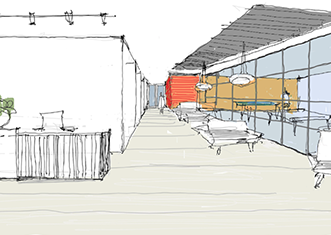They can be dynamic, promote productivity and provide workplaces where employees feel comfortable. Modular offices seem almost a must-have in a working world that is facing a constant change.
Now companies are being asked to be smart and evolve, adapt, and meet the challenges of advancing technology. In short, they encourage innovation. They use the latest software. They live with a vision of the future.
However, there is more to agile workplace design than a concept. These agile principles and methods must also be reflected in the work environment. Today's offices are no longer just places where agile work takes place. Rather, they are part of the process and a new way of thinking, as well as the mirror of the corporate culture. So, office furnishings should not only structurally support processes, but also enhance the overall well-being of employees. The office becomes a social space, a place of interaction where values are lived and exchanged.
To now find out which places are needed in the office and how these can be made available in the most uncomplicated way possible, precise activity and process analyses are required. These are then translated into zoning according to activity and function areas. All of this must be designed individually and in line with specific needs. Modern working environments are structured and furnished with personally or temporarily assigned workplaces, places of retreat, communication zones and service areas in such a way that they offer employees an optimal working and innovation environment.
So, what exactly does modular office design mean?

An agile office is a physical space that can be reconfigured, reorganized, and rearranged as needed. In short, it means adaptive planning, evolutionary development, early deployment, continuous improvement, and rapid and flexible response to change. Traditional design methods ciao ciao, this is where we use modular components.
Spaces are suddenly not covered with walls of plaster and steel. Agile workspaces use prefabricated modular walls, room dividers, raised floors and flexible furniture systems. As a result, companies can change room sizes at a moment's notice, spontaneously responding to increases or decreases in workload while increasing efficiency and productivity.
Now you have cubicles on your mind, first introduced in 1967 under the name "Action Office." But modular design has evolved beyond cubicles. No longer do we find boxes that, once assembled, take time and effort to reorganize. Rather, we welcome lightweight materials and advanced systems.
These innovation spaces must be alive and allowed to evolve and change with the needs of the teams and the company as a whole. Seating and workspaces that can be reconfigured for small and large groups are ideal. This means, for example, integrating folding and movable tables that can also be used as whiteboards, or mobile chairs with writing options and trays that provide storage and seating at the same time.
The ability to change workstation configurations quickly and easily can mean that companies are more willing to make changes and can therefore respond better to changes in the business environment all at once.
What is the secret of flexibility?

It's simple: creating an office space within an office space. The easiest way to do this is with movable walls, such as demountable partitions, and raised floors. These two components help create a truly flexible work environment.
The motto of traditional construction is rigidity. Modular systems, on the other hand, are bursting with flexibility. If the department grows, the space can grow with it; if the department shrinks, the space shrinks accordingly. Raised floor systems and movable walls are the basic building blocks of this back-and-forth change.
Fair enough. But is there more to it than flexible room layout? You bet there is! Movable wall panels can be easily replaced to accommodate style changes. They can also be easily removed, ensuring easy access to integrated power, data, and technology systems. So, if systems need to be updated, it's done quickly and with minimal disruption to the workflow.
Why a modular office?

The most obvious advantage of modular design is flexibility of use. Modules are standardized and interchangeable, making them easy to place within a layout. This can also save real estate costs in the long run, for example, because reducing or maximizing the space required for work performance is intuitively done within the same space, which nevertheless permits this dynamic.
Modular design also means green design. One can move and reuse modules in a variety of ways. For example, modular design can be used to renovate older buildings without impacting the existing infrastructure. In the process, modular wall systems add less source material to the building environment and reduce waste from the start.
As Uncle Scrooge used to say, time is money. Modular design aims to save both. The systems used in modular design are efficient. The movable walls are prefabricated to their full height, minimizing the installation process. At the same time, the materials used in the modular wall system are reusable and recyclable and have a long service life. There is little material waste during construction and installation is essentially dust-free, resulting in better air quality. Of course, wall systems can be more expensive initially than traditional office walls, but the adaptability of the system lowers the cost over time. Ultimately, price is a matter of the final design decision.
Modular: all or nothing?
The decision on office space design does not have to be an all-or-nothing decision. Ultimately, the decision depends on the company's current and future needs. To start, it's easy to experiment with modular components within the traditional design. For example, for now, the work or conference area can be redesigned in a modular way. This can simply involve adding furniture that can be easily reconfigured. This way, you can test your organization's agility capabilities before committing to change. It may not even need to be about becoming completely agile in the beginning, but rather recognizing that some ability to adapt to change exists.
A future-proof office?

You are in the process of designing an office of the future. Office spaces are undergoing a transition in their centering. Space-centeredness suddenly becomes people-centeredness. Companies are driven by people. Successfully structured spaces consider the needs of today's diverse workforce and provide a healthy and engaging workplace. Designing for people means considering a variety of factors from activity and aesthetics to noise and natural light.
Would you like to work freely, away from your desk, day in and day out? In a modular office, no one is tied to their desk anymore. Wireless technology has untethered us from hardwired internet and phone connections, and suddenly everything can be a workspace. Let's give our employees the choice! There are still offices, but nothing rigid anymore. Companies are realizing that flexibility is the best way to future-proof their workplace. The concept allows them to adapt to the changing way employees work.
5 questions to ask before launching the design:
Your office reflects your business and often forms the first impression of your brand. Thus, the question that arises now is:
What should a modular office say about my company?
The company's personal values should be incorporated into the design of the modular office. If the office is more of a place full of creative brainstorming in an open environment, it will need to be designed differently than a private and discreet, but reliable office.
What kind of employee behaviors should my modular office encourage?
The main purpose of a modular office is to provide a comfortable work environment. However, the modular office should also make employees want to come to work. Design the office to meet the needs of your employees. Of course, the way your employees work may differ from the dynamics of other companies.
How much space do I need?
The square footage of a modular office is no longer chosen based on the number of employees. Employees are working more collaboratively, and increasingly from home, so the individual workspace is shrinking, and the collaborative workspace is growing. So now it's a matter of considering how much space employees really need, based on their business practices and their work and attendance habits.
How do I achieve maximum flexibility?
To survive in our fast-paced world, companies nowadays need to be more adaptable than ever. They should take steps to keep their modular office flexible so it can be easily reconfigured. However, modular buildings are inherently more flexible than conventional offices because of their reusable parts.
Change and adaptation processes take time. New agile office environments are not perfect from the start. Their planning and introduction must be accompanied so that they are supported by all teams and used optimally. The principle of trial & error should also be applied to one's own office environment. In this way, spaces for agile working can be adapted again and again to the needs of their teams and projects and continuously perfected.
By developing their own interior design style, an internal, individual employer branding is created. Therefore, it is of enormous advantage to design a sophisticated concept that perfectly reflects the company and its employees. The effect on outsiders shouldn't be underestimated either. A modern office design gives visitors an impression of the company.
In short, strategic office planning is the key to success. The future-proof office must be designed functionally and attractively, fit for the different work areas, and meet the conditions of the future working world.











